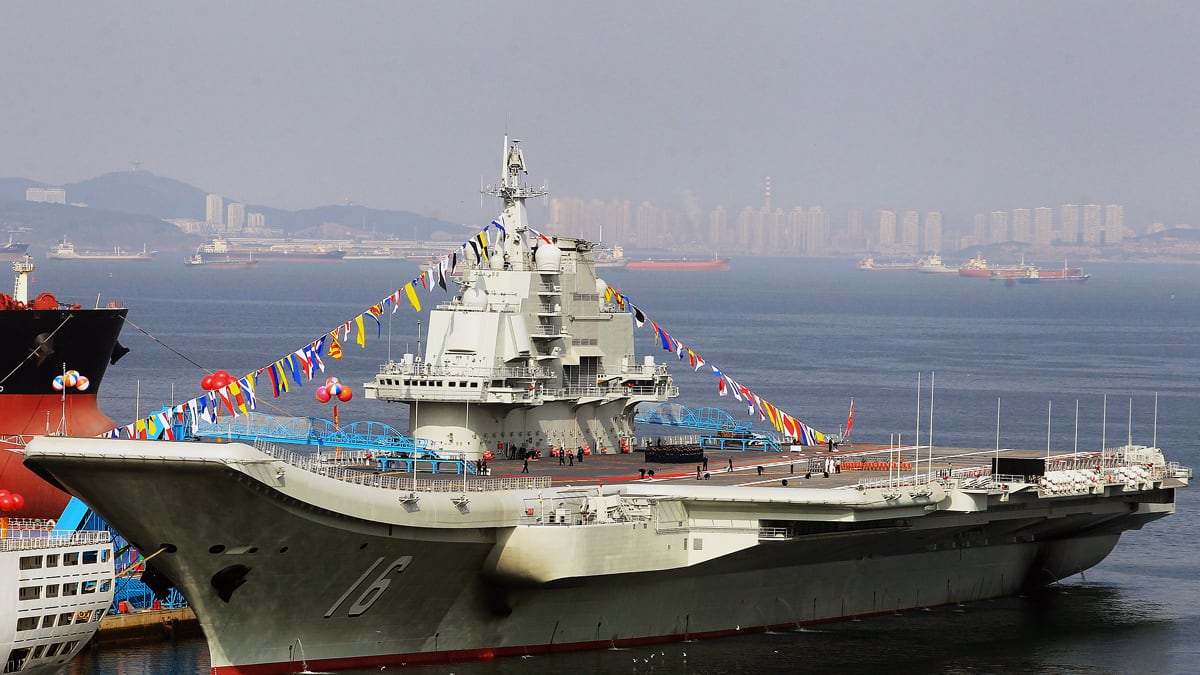The headlines may have read “Navy Sails Into a New Era,” but the scene looked more like something from the heyday of Sino-Soviet friendship in the 1950s: China’s President Hu Jintao, in a somber olive-green Mao suit befitting his role as chairman of the Central Military Commission, inspected the ranks of sailors with fixed bayonets and resolute expressions who formed a guard of honor on the quayside in front of a hulking aircraft carrier originally commissioned by the Soviet Union.
The sailors’ comments seemed like something out of the old lexicon too: “When I received the flag from President Hu, my heart was full of sacred pride,” the ship’s captain, Zhang Zheng, a 43-year-old from Zhejiang province, told China Daily. “My life is worthwhile now that I can serve on our aircraft carrier,” added Sgt. Lin Yuanfeng—while other staff praised the vessel’s “modern dining halls and 24-hour hot water supply” and described its modernity as exceeding their “wildest dreams.”
Chinese military officials certainly are proud of the entry into service of the country’s first aircraft carrier, Liaoning—which one official report described as fulfilling the “70-year dream” of the Chinese nation. The vessel was commissioned in the last years of the Soviet Union, where it was known as the Varyag, before being sold to Chinese buyers by the government of Ukraine in 1998; but over recent years, the carrier, which at 67,500 tons is the same type as those still used by the Russian Navy, and smaller only than the United States’ Enterprise- and Nimitz-class vessels, has been thoroughly retrofitted in the northeastern Chinese port of Dalian, where its unveiling took place. With the exception of its hull, “everything else on the ship was developed and produced ourselves,” a senior official at China’s Air Force Command Institute told the website of a China’s official newspaper People’s Daily.
But some observers see the emphasis on launching a massive, slow-moving aircraft carrier in a time of smart bombs and unmanned drones as a retrograde step in itself. In the United Kingdom, for example, which is in the process of building its own new aircraft carriers after decommissioning the previous generation, many pundits have denounced the vast expense involved in making these giant ships as a waste of money. It’s reminiscent of the debate over China’s plans to put an astronaut on the moon. Isn’t the country’s space program, which has over recent years put people into space and sent back pictures of the first space walk by a Chinese astronaut, simply mimicking what the Americans and Soviets did back in the 1950s and ‘60s, ask some pundits.

But maybe that is, after all, the point. Chinese reports on the new aircraft carrier have emphasized the fact that China is the last permanent member of the United Nations’ Security Council to acquire its own carrier. Some analysts have suggested that owning an aircraft carrier is a bit like the military equivalent of middle-aged men wanting to drive expensive sports cars— it’s all about status and symbolism. For China, being able to project its military power further into the seas off its eastern and southern coasts, where it has various disputes with its neighbors over offshore islands, is clearly important; but having East Asia’s first aircraft carrier (like having a space program) is also simply seen as a way of showing that the country has arrived on the global stage.
And the audience for this message may not only be the international community, long used to space walks and planes taking off from the decks of ships, but also China’s domestic populace. The official Global Times newspaper wrote that such breakthroughs would help China “regain normal development and national dignity” after having been “bullied for a long time,” and described the aircraft carrier as a “milestone of China's construction of power.” “Hopefully, it will also be a psychological milestone for the Chinese people,” it added. “We should say goodbye to our inferiority complex.”
China also is reported to be building more new carriers of its own design. So when Premier Wen Jiabao read out a letter from the nation’s leadership at the unveiling of Liaoning, which described the vessel as being of “great and far-reaching significance in inspiring patriotism and the national spirit and driving national defense technology,” it seemed that a serious point was, after all, being made.






